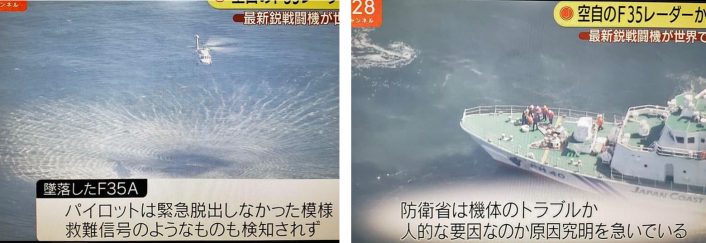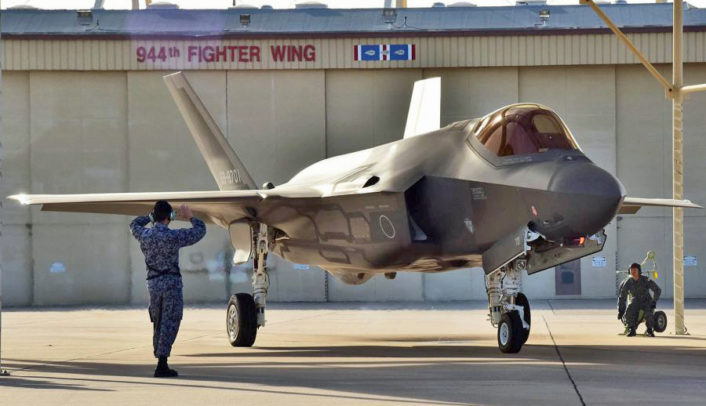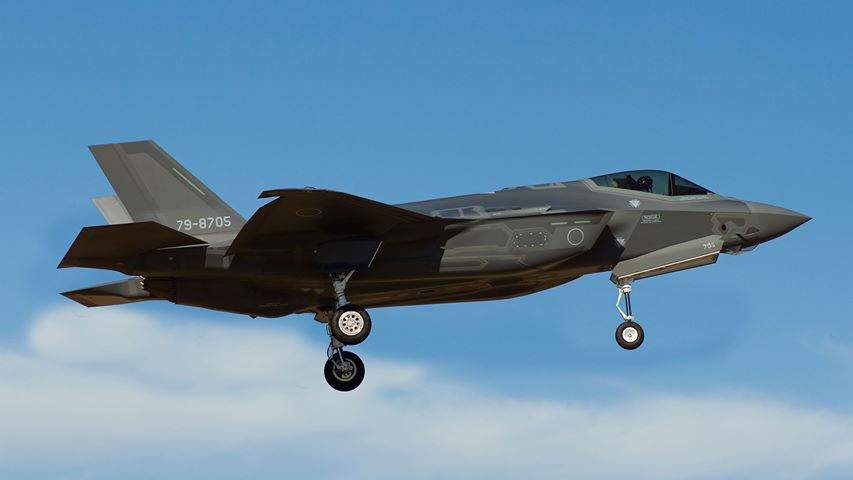U.S. Joins Search Operation for Missing JASDF F-35 Lost in 10,000 Feet of Water.
Sections from the left and right rudders of a Japanese Air Self Defense Force (JASDF) F-35A Lightning II, serialled 79-8705, the first of 13 Japanese F-35s assembled at the Nagoya FACO (Final Assembly and Check-Out), that disappeared in the Pacific Ocean on Tuesday, April 9, 2019 were located by Japanese authorities at approximately 21:45 local on Tuesday, only hours after the aircraft was reported missing.
The aircraft disappeared from a flight of four F-35As at 19:27pm (10:27 GMT) 135km (84 miles) east of Misawa, in north-eastern Japan. The search continues for the aircraft’s pilot, whose identity has not been released but is being described as “a major in his 40’s”.
A report filed by journalist Jon Sharman in The Independent on April 10, 2019 quoted Japanese authorities as saying, “The pilot had signaled he wanted to abort the mission before losing contact.”

A separate report in Stars and Stripes by reporter Hana Kusumoto said that, “The pilot was conducting a nighttime anti-fighter combat drill with three other F-35s”. Kusumoto’s report went on to quote an anonymous spokesman, who told the Stars and Stripes, “communications with the pilot indicated nothing abnormal, although the pilot called off the training before the jet disappeared”.
The F-35 disappeared about 28 minutes after take off.

Water depth in the area where the tail section wreckage was recovered is reported as being “10,000 feet” making search and recovery operations difficult.
Numerous naval an aerial assets can be seen in the F-35 SAR area around 130Km away from Misawa AB. pic.twitter.com/oO70ag6YGl
— Jaime (@DragonLadyU2) April 10, 2019
Some concern in the media has surfaced that other countries may attempt to recover sections of the aircraft in an attempt to gather intelligence about the F-35’s low observable and sensor technology. While interest around the aircraft parts is high, real chances of another country finding and exploiting any of the plane’s remains are unlikely.
“It could present problems depending on what is recovered, when it is recovered and, above all, in which conditions, after impacting the surface of the water,” our own David Cenciotti told Fox News via email. “The F-35 is a system of systems and its Low Observability/stealthiness is a system itself. It is obtained with a particular shape of the aircraft, a certain engine and the use of peculiar materials and systems all those are managed and tightly integrated by million lines of software code: this means that it would be extremely difficult to reverse engineer the aircraft by recoverying debris and broken pieces from the ocean bed. However, there are still lots of interesting parts that could be studied to get some interesting details: a particular onboard sensor or something that can’t be seen from the outside but could be gathered by putting your hands on chunks of the aircraft intakes or exhaust section, on the radar reflectors etc.”
@cencio4 @CombatAir @Aviation_Intel @Rotorfocus
3 Japanese Navy ships are in the scene
1 Coast Guard is going to the area also pic.twitter.com/7PM5LlVxOW
— Juanma Baiutti (@juanmab) April 9, 2019
Reports also indicate the U.S. has joined the search with a Navy P-8A Poseidon maritime patrol aircraft and the Arleigh-Burke class destroyer, USS Stethem (DDG-63). Reports that had surfaced on Twitter that a B-52 launched from Guam had joined the rescue efforts were denied by the Pentagon.
Recovering the wreckage (or the most important parts of it) is important to investigate the incident.
As a result of Tuesday’s incident, all 12 of the remaining Lockheed F-35A Lightning IIs in service with the JASDF’s 302nd Squadron now located at Misawa have been grounded. Japan’s 302nd Hikotai is famous for formerly operating the F-4EJ “Kai” Phantom II. The transition to operational status for Japan’s new F-35A Lightning IIs took place on March 26, 2019.
This is only the second loss of an F-35 Joint Strike Fighter since the aircraft first flew 13 years ago in 2006. A U.S. Marine F-35B Short Take-off and Landing variant crashed on September 28, 2018 near MCAS Beaufort, South Carolina only a day after the U.S. Marines first used the aircraft in combat in Afghanistan. The pilot safely ejected in that incident. Some reports suggest the crash may have been caused by a fuel line problem. As a result of the incident, the Marines conducted a temporary grounding, inspection and replacement of some of the F-35 fuel lines in 2018.
The F-35 Joint Strike Fighter is currently produced in three versions and is in use with or being considered for use by Australia, Canada, Denmark, Italy, Netherlands, Norway, Turkey, United Kingdom, Israel, Japan and South Korea. Belgium and Finland has also indicated an interest in the program, although cost and other concerns have made the program a political hot-point for some nations. As of December, 2018, there were more than 355 Lockheed F-35 Joint Strike Fighters flying in various services around the world with production of the three variants continuing. Both Israel and the U.S. Marines have employed the F-35 in combat.









